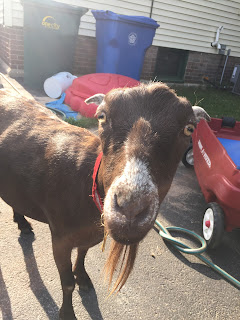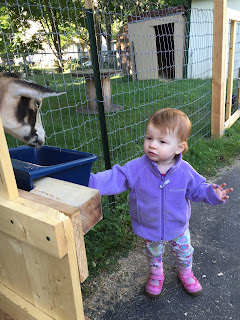After I got the (reluctant) go-ahead from the husband to proceed with goat acquisition, I had to figure out how the heck to find them! I had researched the dairy goat breeds and decided on Nigerian Dwarfs. They're small, have very sweet, rich milk, and I figured they would work well in a city backyard homestead.
First, I checked online by simply searching for "Nigerian Dwarf breeders in (city name)." There were a few breeders near me, but their goats were quite fancy. I didn't need an award-winning goat for $700. At the time, I didn't even care if the goat was registered or not, but that did change later. So, the google search struck out.
Next I searched on Craigslist. This yielded a number of possibilities at first. The more I researched buying goats, the more I learned about what I was looking for, and what a breeder needed to provide. For one, I knew I HAD to buy tested animals. There are three diseases for which you really need to test goats: CAE (Caprine Arthritis and Encephalitis), CL (Caseous Lymphadenitis), and Johne's. I was most concerned about Johne's, but I didn't particularly want a goat with any of the above diseases. I'll give a little overview of each.
CAE
There is some debate in the goat world about whether or not this is really such a bad disease. Only 10% of goats that test positive on the test for CAE will ever show symptoms, but many different ailments have been attributed to it, such as hard udders that are unable to be milked and swollen joints that eventually lead to an inability to walk. The arthritic version of this disease typically affects does over a year old. The encephalitic version is seen less often, and affects kids. It can cause seizures and death. CAE is a retrovirus and there is no known cure. The trouble with testing for CAE is the testing can only test for the antibody, not the actual presence of the virus. This means that while the goat may have come in contact with the virus, it is possible that the goat has successfully fought the virus and will not suffer any ill effects of it. As I said before, only 10% of goats that test positive ever show symptoms. I think it is possible that there are multiple mutations of the virus, some of which cause problems and some do not. Thus, there is debate whether or not this virus is such a big deal, but I think it would certainly make it much more difficult to sell any offspring of a doe that has tested positive, so I decided not to purchase any positive does.
CL
CL is a chronic and highly contagious disease. It causes swelling and abscesses of the lymph nodes, and can decrease meat/milk production and breeding ability. Abscesses can occur both inside and on the outside of the goat's body, so it is not always possible to tell if the goat is infected with CL by looking at it. There is a vaccine, but once the goat gets the vaccine, it will always test positive for CL, and the vaccine may not be very effective. People usually cull (kill) any infected goats.
Johne's
Johne's is the disease I cared most about. It is a chronic intestinal disease similar to Crohn's disease in humans. It causes chronic diarrhea, weight loss, and eventually, death. It is caused by a bacterium named Mycobacterium avium ss.paratuberculosis (MAP). The MAP bacterium has been implicated in some studies as the one that also may cause Crohn's disease in humans, though more research is necessary. It is extraordinarily resistant and can live in soil for decades, so getting a goat with this disease can be very serious indeed, because you may never be able to rid your land of the bacteria, which continues to reinfect new goats. It is unknown whether or not Johne's can infect humans, but I didn't want to take a chance. My husband's siblings both have Crohn's disease, so if there is a genetic vulnerability that could lead my children to get Crohn's from the goats, there's a good chance we have it, and I'm not risking that possibility.
SO, finding goats on Craigslist that had been tested for the above diseases proved somewhat difficult.
The first breeder I contacted agreed to get her goats tested, but she honestly did not sound very knowledgeable. I drove an hour to meet her and the goats. I still had no idea what a "healthy" goat looked like at the time, but I did think her goats were not quite as cute as some others I had seen.
So, I was right to think something was probably off about these goats. As it turns out, I think they probably had mites/lice or nutrient deficiencies. This goat has hair missing on the nose, which means she's been scratching it. Healthy goats don't constantly scratch and lose hair. They're scratching because they're itching from bugs or itchy skin, which can be caused by a zinc deficiency. Additionally, her coat is very dull and wiry, which is indicative of a copper deficiency. So, long story short, this breeder probably is not very knowledgeable, and thus not a good choice. This goat's bag also doesn't have great attachments and hangs a bit low. This can cause problems later if it continues to sag lower.
This breeder was originally only selling one goat, but since I needed two, she agreed to sell another one so the first would have a friend. I began to have doubts about the health of her goats, so I kept looking at Craigslist every day for more ads.
There was one ad that I kept passing up. There was a mini Lamancha for sale, that was half Nigerian Dwarf, half Lamancha. This goat, poor baby, was just the ugliest goat I'd ever seen.
AHAHA! I just couldn't take this goat seriously. BUT, we're going to come back to this sweetheart.
Another goat popped up and she was VERY pretty. Then I realized that that was what a goat SHOULD look like--bright eyes and a shiny, soft coat.
Here's Miss Fiona:
I decided to buy the pretty goat and maybe only one from the first breeder, that way I'd at least have one healthy-looking goat. I had my reservations about the first breeder's goats, but I still wanted goats and, well, they were available. When I contacted the first breeder to tell her I would only be taking one goat, she wrote back something to the effect of "this is the answer to my prayers. I didn't really want to sell my girls, so I'm not offering either at this time. Have a blessed life."
Thanks.
At this point I was beginning to get VERY discouraged at this process. The mom of the pretty goat told me about a number of facebook groups that turned out to be VERY useful. I joined two Nigerian Dwarf facebook groups, one of which was a sale group, and restarted my search. Then this little lady popped up on my newsfeed:
Lexi. Blue eyes, black and white flashy markings, good genetics. She was perfect. I immediately contacted the breeder, and was SO EXCITED! I was going to have two, nice looking and well cared-for goats, and I could not have been happier. Lexi was due to kid in a few weeks, so she would be in milk when I got her. Her due date came, and went, and then a week passed. The breeder had no idea WHAT was going on. I kept trying to update Fiona's mom about the situation. She was getting a new baby goat in VERY soon, and really needed Fiona gone.
While we were waiting for Lexi to stop holding her kids hostage, I continued to research goats. Through this research, I realized that Fiona *might* be a little chunky. I certainly am not one to body shame a goat, BUT it could lead to issues breeding. For whatever reason, fluffy goats tend to struggle with getting pregnant, and if they DO get pregnant, they may have big kids that get stuck. Sadly, I started to have some concerns about Fiona, but not so much so that I'd give her up. At least, not because she was fluffy.
Fiona's mom was definitely very honest about her personality. She was a very dominant goat. She tended to mount her poor little wethers (castrated males) and flap her tongue at them. We both just assumed she was desperate for some action and wondering WHY THE HECK the little wethers weren't up to the task, so I wasn't too worried about that. UNTIL we had a convo about how noisy she is.
Fiona's mom asked if I could maybe take Fiona even though I didn't have Lexi yet, because she didn't really want her there when the baby got there. I said I maybe could, but I was worried that Fiona would be really upset and scared being alone, and might scream (look up youtube videos on screaming goats if you want to get an idea of what I mean). To this she responded "oh...she'll definitely scream. She's very...vocal. She's a noisy goat."
Uh oh.
The one thing I did NOT want was a noisy goat. You can't have a noisy, screaming goat in the city. Obviously goats make SOME noise, but they aren't all screamers. We came to the mutual decision that Fiona would not be a good fit for me. I decided that this was probably for the best, since I had been having concerns about Fiona's breeding capabilities anyway.
I then contacted Lexi's breeder to tell her the situation, and I asked if she had any other goats she was selling at the time. I was honest with her that Fiona fell through because she was a screamer, and Lexi's breeder wrote back "I'm sorry, but I'm refunding your deposit. You have unrealistic expectations. Goats are farm animals, and they're not silent. I don't have a good feeling about this. Sorry."
I cried. I didn't just cry, I WEPT. My husband came downstairs and saw me tearing up, and thought someone had died or something. I haven't mentioned the DOZENS of goats I'd inquired about that weren't from tested herds, or were already sold, or had been sent to auction, or WHATEVER. Seriously, I'd looked at dozens of goats, and when I was ready to get my goats any day, they BOTH fell through. I had the pen, the house, everything ready, and had sunk thousands of dollars into getting ready, and they were both gone. At this point, I felt like I'd totally failed and had just wasted SO much of my family's money that we really didn't have to waste. Weeping. I was weeping. And my husband, who DID NOT AT ALL want these blasted goats, tried to comfort me and build me back up. Love that man.
SO, I texted Lexi's breeder back and said something like "that is a REALLY CRUMMY (not the word I wanted to use) thing to do. I do not have unrealistic expectations. There's a difference between normal goat maaas and a screaming goat. I have their pen all ready, they have a home, I had to get a license for them, I've researched for months, and I would make a GREAT goat mom." So, she called me and we talked. I sent her a picture of their pen, assuaged her fears, and we were back on. PHEW! But, I still had to find another goat.
Re-enter to the scene, Ugly Goat.
Hahaha...I just had to put that again. I'd messaged UG's mom at least 3 times asking if she was still available, and pauvre bette, she always was. I messaged her again after Fiona fell through, and, of course, she was still available! So, I considered it written in the stars that she was supposed to be mine. I mean, WHO am I to judge her on appearance?? Maybe she has a great personality.
Everyone was waiting and waiting and waiting for Lexi to have her kids. She finally did, and she had a terrible time of it. Long labor, a kid had to be pulled (as in, dragged out of her), she bled more than she should have after kidding, and got an infection. She had a ROUGH go of it, and the breeder thought maybe she should dry her up and not sell her. Heart broken AGAIN!
BUT!!! Ray of sunshine! The breeder decided to let me have a different goat in Lexi's place. This goat was very sweet, and very docile. In short, she was absolutely perfect for my family. I really think this worked out EXACTLY as it should have. Thus, Paisley Moon entered the story:
Blue eyes, buckskin coat. BEAUTIFUL udder with perfect teat placement. She was a steal, I tell you.
So, Ugly Goat (Hermione) and Paisley became my very first, very own GOATS!
Day 1 of Goatdom will be the next blog installment, and it's a doozie. I love those darn goats now, but the first day was ROUGH. Stay tuned!






















































